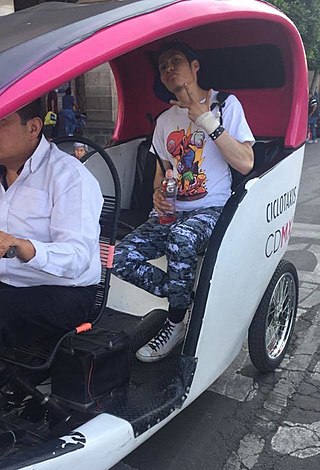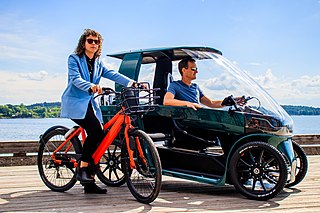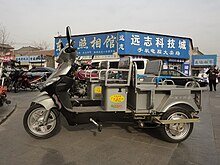
Transport in India consists of transport by land, water and air. Road transport is the primary mode of transport for most Indian citizens, and India's road transport systems are among the most heavily used in the world.

The cycle rickshaw is a small-scale local means of transport. It is a type of hatchback tricycle designed to carry passengers on a for-hire basis. It is also known by a variety of other names such as bike taxi, velotaxi, pedicab, bikecab, cyclo, beca, becak, trisikad, sikad, tricycle taxi, trishaw, or hatchback bike.

An auto rickshaw is a motorized version of the pulled rickshaw or cycle rickshaw. Most have three wheels and do not tilt. They are known by many terms in various countries including auto, auto rickshaw, baby taxi, mototaxi, pigeon, jonnybee, bajaj, chand gari, lapa, tuk-tuk, tum-tum, Keke-napep, Maruwa, Adaidaita Sahu, 3wheel, pragya, bao-bao, easy bike, and tukxi.

A three-wheeler is a vehicle with three wheels. Some are motorized tricycles, which may be legally classed as motorcycles, while others are tricycles without a motor, some of which are human-powered vehicles and animal-powered vehicles.

A solar vehicle or solar electric vehicle is an electric vehicle powered completely or significantly by direct solar energy. Usually, photovoltaic (PV) cells contained in solar panels convert the sun's energy directly into electric energy.

An electric bus is a bus that is propelled using electric motors, as opposed to a conventional internal combustion engine. Electric buses can store the needed electrical energy on board, or be fed mains electricity continuously from an external source such as overhead lines. The majority of buses using on-board energy storage are battery electric buses, where the electric motor obtains energy from an onboard battery pack, although examples of other storage modes do exist, such as the gyrobus that uses flywheel energy storage. When electricity is not stored on board, it is supplied by contact with outside power supplies, for example, via a current collector, or with a ground-level power supply, or through inductive charging.

An electric bicycle, e-bike, electrically assisted pedal cycles, or electrically power assisted cycles is a motorized bicycle with an integrated electric motor used to assist propulsion. Many kinds of e-bikes are available worldwide, but they generally fall into two broad categories: bikes that assist the rider's pedal-power and bikes that add a throttle, integrating moped-style functionality. Both retain the ability to be pedaled by the rider and are therefore not electric motorcycles. E-bikes use rechargeable batteries and typically are motor-powered up to 25 to 32 km/h. High-powered varieties can often travel more than 45 km/h (28 mph).
The automotive industry in India is the world's fourth-largest by production and valuation as per 2022 statistics. As of 2023, India is the 3rd largest automobile market in the world in terms of sales.
Ashok Jhunjhunwala is an Indian academic and innovator. He received his B.Tech. from the Indian Institute of Technology, Kanpur and PhD from the University of Maine. He has been a faculty member at the Indian Institute of Technology Madras since 1981. He is the President of IIT Madras Research Park and Chairman of International Institute of Information Technology, Hyderabad. During his career, he has contributed extensively to technology innovation and adoption in the Indian context.

Jugaaḍ is a non-conventional, frugal innovation, in South Asia. It also includes innovative fixes or a simple workarounds, solutions that bend the rules, or resources that can be used in such a way. It is considered creative to make existing things work and create new things with meager resources.
The energy policy of India is to increase the locally produced energy in India and reduce energy poverty, with more focus on developing alternative sources of energy, particularly nuclear, solar and wind energy. Net energy import dependency was 40.9% in 2021-22.

Mahindra Last Mile Mobility Limited, formerly known as Mahindra Electric Mobility Limited (2016-2023) and Reva Electric Car Company (2010-2016), is an Indian company based in Bangalore that designs and manufactures compact electric vehicles. The company's first vehicle, the REVAi electric car, was available in 26 countries with 4,000 versions sold worldwide by mid-March 2011. Reva was acquired by Indian conglomerate Mahindra & Mahindra in May 2010. After the acquisition, the company launched the electric hatchback e2o in 2013. Today, the company sells electric vehicles in different segments – the electric sedan eVerito, the electric commercial vehicle eSupro, and the Treo range of low maintenance, lithium-ion battery-powered three-wheelers. Recently, Mahindra Electric became the first Indian car manufacturer to cross 170 million kilometres travelled on its fleet.

A battery electric vehicle (BEV), pure electric vehicle, only-electric vehicle, fully electric vehicle or all-electric vehicle is a type of electric vehicle (EV) that exclusively uses chemical energy stored in rechargeable battery packs, with no secondary source of propulsion. BEVs use electric motors and motor controllers instead of internal combustion engines (ICEs) for propulsion. They derive all power from battery packs and thus have no internal combustion engine, fuel cell, or fuel tank. BEVs include – but are not limited to – motorcycles, bicycles, scooters, skateboards, railcars, watercraft, forklifts, buses, trucks, and cars.

In the Philippines, motorized tricycles, or simply tricycles, refer to a type of motorized vehicle consisting of a motorcycle and a passenger cab attached to it. Along with the jeepney, the Philippine tricycle is one of the most common means of public or private transportation in the country, especially in rural areas. These public utility vehicles either ply a set route or are for-hire, like taxis.

Rickshaw originally denoted a pulled rickshaw, which is a two- or three-wheeled cart generally pulled by one person carrying one passenger. The first known use of the term was in 1879. Over time, cycle rickshaws, auto rickshaws, and electric rickshaws were invented, and have replaced the original pulled rickshaws, with a few exceptions for their use in tourism.

A solar bus or solar-charged bus is a bus that is powered exclusively or mainly by solar energy. Solar-powered bus service is referred to as a solar bus service. The use of the term "solar bus" normally implies that solar energy is used not only for powering electric equipment on the bus, but also for the propulsion of the vehicle.
The electric vehicle industry in India is slowly growing. The central and state governments have implemented schemes and incentives to promote electric mobility, and have introduced regulations and standards.
Pakistan has a significant market for hybrid vehicles such as Honda's Vezel, Toyota's Prius, and Aqua. The Automotive Development Policy (2016–2021) and the launch of the China-Pakistan Economic Corridor (CPEC) encourage foreign investments for new automobile brands to enter the Pakistani market, while the leading manufacturers in the automobile industry in Pakistan are interested in introducing electric vehicle (EV) models with a wide range of prices for consumers of diverse income groups. Several members of the international automobile industry including South Korea, China, and Japan also believe that Pakistan has a high potential market for EV technology, leading them to collaborate with local businesses to bring EVs to Pakistan.
The manufacture, sale, and adoption of electric vehicles in Thailand is supported by the Thai government, in order to reduce carbon emissions and air pollution. Prime Minister Prayut Chan-o-cha appointed the National Electric Vehicle Policy Committee in February 2020 to set targets for zero emission vehicle adoption. The government has announced aims for 30% of automobiles produced in 2030 to be electric, and to become a regional hub for electric vehicle manufacturing.

SUN Mobility is an electric vehicle energy services company founded in 2017 that develops, manufactures and operates battery swapping infrastructure for electric two-wheelers, three-wheelers, and larger commercial vehicles. Battery swapping technology helps accelerate the faster adoption of electric vehicles due to the lower upfront purchase price of electric vehicles, and the lower running costs - particularly in the case of commercial applications.





















